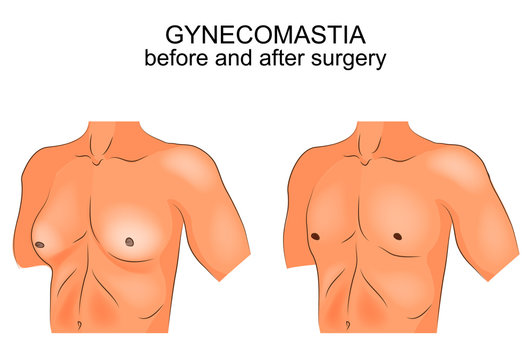Gynecomastia surgery is a medical procedure aimed at reducing excess breast tissue in men, which can be a source of embarrassment and distress. This article will provide you with an in-depth understanding of gynecomastia, the surgical options available, and the necessary preparations and considerations.
Table of Contents
Understanding Gynecomastia
Causes of Gynecomastia
Gynecomastia is a condition characterized by the enlargement of breast tissue in males, usually caused by an imbalance in estrogen and testosterone levels. Various factors can contribute to the development of gynecomastia, including:
- Hormonal imbalances
- Obesity
- Aging
- Use of certain medications
- Substance abuse
- Medical conditions such as liver disease and kidney failure
Symptoms and Diagnosis
The primary symptom of gynecomastia is the enlargement of one or both breasts. This enlargement may be accompanied by tenderness, pain, or discharge from the nipples. A physical examination and medical history are usually sufficient for diagnosis, but additional tests may be necessary to rule out underlying health conditions.

Gynecomastia Surgery: An Overview
Gynecomastia surgery aims to reduce excess breast tissue and contour the chest to a more masculine appearance. The surgery typically involves removing glandular tissue, excess skin, and/or fat, depending on the severity of the condition.
Types of Gynecomastia Surgery
There are three main types of gynecomastia surgery:
Liposuction
Liposuction is a minimally invasive procedure that removes excess fat from the chest area using a small cannula. This method is best for patients with mild to moderate gynecomastia, where the primary issue is excess fat rather than glandular tissue.
Excision
Excision involves the surgical removal of glandular tissue and excess skin. This method is more appropriate for patients with severe gynecomastia or significant skin redundancy.
Combination of Liposuction and Excision
In some cases, a combination of liposuction and excision may be necessary to achieve the desired results. This approach allows the surgeon to remove both fat and glandular tissue while contouring the chest.
Preparing for Gynecomastia Surgery
Consultation with a Surgeon
A consultation with a board-certified plastic surgeon is the first step in determining whether gynecomastia surgery is appropriate for you. During the consultation, the surgeon will evaluate your
medical history, discuss your concerns and expectations, and assess the severity of your gynecomastia. Based on this information, the surgeon will recommend the most suitable surgical approach for your case.
Preoperative Guidelines
Prior to surgery, you will be provided with specific instructions to help ensure a successful outcome. These may include:
- Stopping certain medications and supplements that can increase bleeding risk
- Quitting smoking to promote better healing
- Maintaining a healthy diet and exercise regimen to optimize your overall health
- Arranging for postoperative care and assistance during the recovery period
The Surgery Process
Anesthesia
Gynecomastia surgery is typically performed under general anesthesia or local anesthesia with sedation, depending on the complexity of the procedure and your surgeon’s recommendation.
Surgical Procedure
The specific surgical technique used will depend on the type of gynecomastia surgery you are undergoing:
- Liposuction: Small incisions are made in the chest area, and a cannula is inserted to suction out the excess fat.
- Excision: An incision is made around the areola or along the natural chest crease to remove excess glandular tissue and skin.
- Combination of Liposuction and Excision: Both techniques are used in tandem to achieve optimal results.
Recovery and Aftercare
The recovery process varies depending on the extent of the surgery. You can expect some swelling, bruising, and discomfort in the days following the procedure. Your surgeon will provide you with postoperative care instructions, including pain management, wound care, and activity restrictions. Most patients can return to work within one to two weeks, but strenuous activities should be avoided for at least four to six weeks.

Risks and Complications
As with any surgery, there are potential risks and complications associated with gynecomastia surgery, such as:
- Infection
- Bleeding
- Scarring
- Asymmetry or contour irregularities
- Changes in nipple sensation
It’s essential to discuss these risks with your surgeon and carefully follow their pre- and postoperative guidelines to minimize complications.
Cost of Gynecomastia Surgery
The cost of gynecomastia surgery varies depending on factors such as the surgeon’s experience, the complexity of the procedure, and the geographical location. It’s important to consider that the total cost includes not only the surgeon’s fee but also anesthesia, facility fees, and any additional expenses.
Is gynecomastia surgery covered by insurance?
Can gynecomastia return after surgery?
How long do the results of gynecomastia surgery last?
Can exercise help reduce gynecomastia without surgery?
When can I start exercising after gynecomastia surgery?
Conclusion
Gynecomastia surgery is a life-changing procedure that can help restore a more masculine chest contour and improve self-confidence. By understanding the causes of gynecomastia, the different surgical options, and the necessary preparations, you can make an informed decision about whether this procedure is right for you.

You May Also Like: Gynecomastia: Vaser Liposuction vs Traditional Liposuction – Which is the Better Option?



